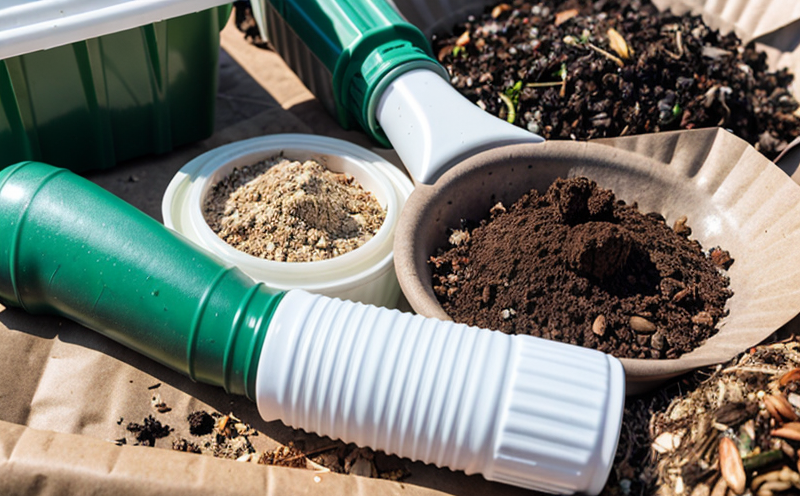ISO 14855 Determination of Ultimate Aerobic Biodegradability of Organic Waste
The ISO 14855 test method is a critical tool in the waste management and recycling testing sector, particularly for assessing the ultimate aerobic biodegradability of organic materials. This test provides essential data for manufacturers, waste management firms, and environmental researchers to ensure that products meet regulatory standards for compostability.
The ISO 14855 method evaluates how effectively a given material degrades in an aerobic environment over time. The process involves incubating the sample under controlled conditions for up to 6 months, during which time its mass loss is measured. This measurement indicates the extent of biodegradation that has occurred.
The test parameters are meticulously defined to ensure accurate and consistent results. Samples are prepared by drying them in an oven at a specified temperature until constant weight is achieved. The dried samples are then ground into a fine powder, ensuring uniform particle size for even degradation testing. After preparation, the samples undergo incubation in a sealed flask containing 20% (w/v) glucose solution and 80% distilled water.
Once incubated under aerobic conditions at 55°C ± 1°C, the samples are weighed periodically to determine the rate of mass loss due to biodegradation. Acceptance criteria for passing the test typically require a minimum degradation rate over specified time intervals. Compliance with these standards ensures that materials can be safely and effectively composted without causing environmental harm.
For quality managers and compliance officers, the ISO 14855 method offers clear guidelines on how to ensure products meet regulatory requirements for biodegradability. This is especially important in markets like Europe, where strict regulations govern what can be labeled as "compostable." For R&D engineers, this test provides a reliable framework for developing new compostable materials and optimizing existing formulations.
Proper sample preparation and incubation conditions are crucial to obtaining accurate results. The use of standardized protocols ensures that all tests conducted adhere to the same rigorous standards, enhancing confidence in the data generated. This consistency is vital for making informed decisions about product development and compliance strategies.
Applied Standards
| Standard Number | Description | Status |
|---|---|---|
| ISO 14855-1 | Determination of ultimate aerobic biodegradability - Part 1: Test methods using the Erwinia culture method | Current |
| ISO 14855-2 | Determination of ultimate aerobic biodegradability - Part 2: Test methods using the modified Stirling bottle method | Current |
| Standard Number | Description | Status |
|---|---|---|
| ASTM D5338 | Determination of ultimate aerobic biodegradability in soil using the Erwinia culture method | Current |
| EN 17033 | Biodegradable plastics - Determination of composting conditions | Withdrawn |
Benefits
The ISO 14855 test method offers numerous benefits to stakeholders in the waste management and recycling sector. For manufacturers, it provides a robust framework for developing products that meet strict biodegradability standards. This not only enhances product sustainability but also opens up new markets where regulatory compliance is essential.
For waste management firms, this test method aids in optimizing waste streams to ensure they are processed appropriately. By identifying which materials can be composted effectively, these firms can reduce landfill contributions and improve overall environmental performance. For procurement teams, ISO 14855 offers a consistent way to evaluate suppliers' products against biodegradability criteria.
The test also supports the broader goal of reducing waste and promoting circular economy principles by ensuring that materials used in packaging and other applications can be safely returned to nature through composting. This contributes significantly to sustainability efforts and helps companies meet their environmental goals.
Environmental and Sustainability Contributions
The ISO 14855 test method plays a pivotal role in advancing sustainability by ensuring that products are genuinely biodegradable, thus reducing the burden on landfills. By promoting the use of compostable materials, this test supports the transition to a more circular economy where waste is minimized and resources are reused effectively.
Composting is an environmentally friendly process that turns organic waste into valuable soil amendments. The ISO 14855 method helps ensure that products contribute positively to this cycle by degrading completely in composting conditions. This not only reduces the amount of non-biodegradable waste but also enriches soil with nutrients, supporting healthier ecosystems.
For quality managers and R&D engineers, compliance with ISO 14855 is essential for product innovation. It encourages the development of materials that are safe for both human health and the environment. By adhering to these standards, companies can demonstrate their commitment to sustainability, enhancing their reputation among eco-conscious consumers.





